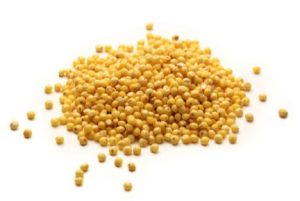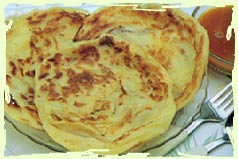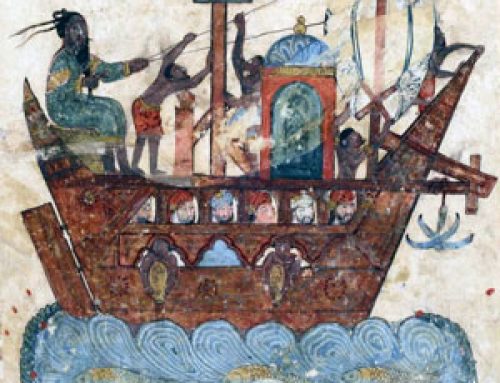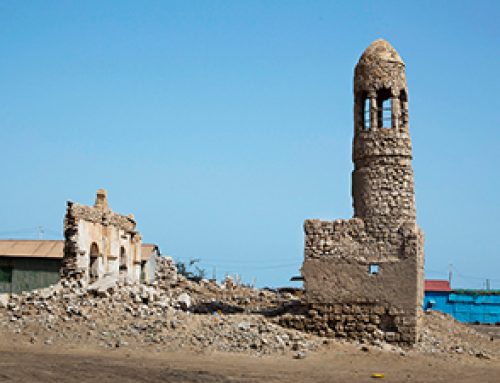
A field of millet
What is millet?
Millet is a kind of grain that grows wild in Africa and all across Europe and Asia. It grows about fifteen feet tall, like corn on the cob (it looks kind of like corn when it is growing, too). Millet grows fast, and doesn’t need very much rain, so it’s a good crop for dry or cold climates. It will grow in places where wheat and barley will not grow. Also, millet is easy to store. You can keep it up to five years. So it’s good for places that have long winters or often have droughts.
History of wheat
History of barley
Where do oats come from?
Where does corn come from?
How about rice?
Early Chinese food
All our China articles

A pile of millet seeds
Broomyard millet in China
There are three different kinds of millet, and people started farming the three kinds independently. The first kind was broomyard millet, which grew wild in China, and hunters and gatherers in early China probably ate millet.
Stone Age China
Early farming
People have been farming broomyard millet in Northern China since about 8,000 BC. Northern China was dry and cold, so it was a good place to grow millet. By around 5000 BC, people in north-central China were relying on millet as a staple food, and by about 3000 BC millet was a staple food all over northern China. The sign for millet is common in Chinese writing, where the signs for “millet” and “mouth” put together mean “good”, and the signs for “millet” and “man” together mean “harvest” or “year”.
Pearl millet in Africa
The second important kind of millet is pearl millet. It grows wild in the Sudan (south of the Sahara Desert) in Africa. By 4000 BC, people in the Sudan were farming pearl millet, and from there pearl millet spread to East Africa and then to Egypt by around 3000 BC. The Egyptians made a flat bread like pita bread out of pearl millet. From East Africa millet also spread to India, where people were farming it by about 2500 BC. The Harappans also used millet to make roti, a kind of flatbread like pita bread.
Early Sudan’s history
Early African food
Early Indian food

Roti bread made with millet
Panic millet in Europe and West Asia
A third kind of millet – also called “panic” – grew wild in West Asia and Europe. Around 4000 BC, lake-dwelling Europeans were farming that millet, and by 3000 BC Sumerians in West Asia were also growing millet.
Northern European history
Who were the Sumerians?
Food of Northern Europe
Food in West Asia
People were farming millet in Israel by 600 BC, and the Greek historian Herodotus, writing in the 400s BC, says that both the Persians and the Greeks were growing millet in his time. People were also eating millet in Roman Italy.
By the 100s BC, people in West Asia and Europe were growing both the native “panic” millet and the Chinese broomyard millet. Some people liked one better, and some people liked the other.
But in the southern Mediterranean, people were still eating African pearl millet, and pearl millet also spread from Eastern Africa south down the coast and became more and more common in southern Africa too. By this time, people in China were making wine out of broomyard millet, while in Africa, people made beer out of pearl millet.
History of beer
 How did people cook millet?
How did people cook millet?
People in Europe about this time usually ate millet boiled in water or milk like oatmeal or polenta. In the Roman Republic, people called this puls, and it was the most common food of really poor people. Medieval Europeans and northern Chinese people kept on eating millet porridge (Medieval Europeans called it groats), but around 1000 AD, North African people started making their millet into couscous instead of porridge, maybe imitating rice.
Medieval African food
Food in the Roman Empire
Where do people eat millet today?
As people in Europe, West Asia, and China got richer, they gradually stopped eating millet; in America today, we use millet mainly for birdseed. Today even in North Africa, most people make couscous out of wheat instead of millet. But in poorer countries, especially if it is very dry and hot, people still eat a lot of millet. Mostly that’s in Mali, Nigeria, Niger, and India, where people eat pearl millet. Even in India, though, these days more and more millet goes to feed animals instead of people.
Learn by doing: try making millet porridge with milk
More about millet in China
Bibliography and further reading about millet:
Food, by Fiona MacDonald and others (2001). Easy facts about food from all over the world. A little preachy.
Food in Antiquity: A Survey of the Diet of Early Peoples, by Don and Patricia Brothwell (1998). Pretty specialized, but the book tells you where foods came from, and how they got to other places, and what people ate in antiquity. Not just Europe, either!
Food: A Culinary History from Antiquity to the Present, by Jean Louis Flandrin, Massimo Montanari, Albert Sonnenfeld. (1996). Hard going because it is translated from French, but Flandrin was one of the world’s great food historians.




